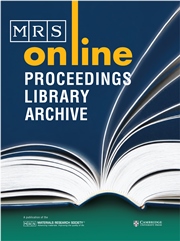Article contents
Growth of Epitaxial Potassium Niobate Film on (100)SrRuO3/(100)SrTiO3 by Hydrothermal Method and their Electromechanical Properties
Published online by Cambridge University Press: 01 February 2011
Abstract
Epitaxaially-grown KNbO3 thick films over 8 μm in thickness were successfully grown at 220 °C for 6 h on (100)cSrRuO3//SrTiO3 substrates by a hydrothermal method. Epitaxial SrRuO3 layers grown on (100)cSrTiO3 substrates by sputter method were used as bottom electrode layers. Relative dielectric constant and the dielectric loss were 530 and 0.11, respectively. Clear hysteresis loops originated to the ferreoelectricity were observed and a remanent polarization was 25 μC/cm2 at a maximum applied electric field of 540 kV/cm. In addition, the hydrothermal KNbO3 thick film was able to transmitting and receiving of ultrasonic waves over 50MHz.
- Type
- Research Article
- Information
- Copyright
- Copyright © Materials Research Society 2009
References
REFERENCES
- 1
- Cited by




